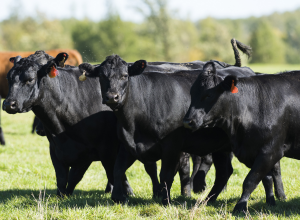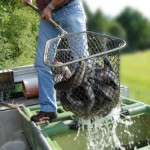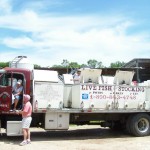 Managing cattle during a drought isn’t fun at all. Depending on the length of the drought, cattle must be culled. When a cattle producer genetically selects for a desired group of cattle, it becomes very disheartening to be placed in the position where a forced sell becomes necessary. To a cattle producer, those cows are more than a group of cows. They are often times a lifetime of investment.
Managing cattle during a drought isn’t fun at all. Depending on the length of the drought, cattle must be culled. When a cattle producer genetically selects for a desired group of cattle, it becomes very disheartening to be placed in the position where a forced sell becomes necessary. To a cattle producer, those cows are more than a group of cows. They are often times a lifetime of investment.
- No rain no plant growth – once it stops raining, you’ve got all the grass growth you’re going to get until it rains again.
- Drought is never a surprise – it progresses over time. All the signs were there for a long Arkansas drought: very warm winter, spring came six weeks earlier than normal, the first cutting of hay came 4 weeks earlier than normal and was 40 to 60% less than normal and most of the state received little to no rain in April and May.
- Management of drought is the balancing of forage and water supply with forage and water demand. Remember in a drought the forage and water supply decreases while forage and water demand stays the same unless cows are culled.
- How long will the drought last? When is the next probably for rain? September? October? November? So the drought will last at least 7 to 8 months (April to November)
- During a drought always monitor current water and feed inventories. During hot days with low humidity, pond levels can evaporate rather quickly. Standing forage can also vanish rather rapidly.
- Monitor the body conditions of the cowherd. If the drought persists and cows must be culled, the selling prices (price per pound) for cull cows are based on body condition or body weight. There is a positive relationship between body condition and price per pound. That means as body condition goes up so does the selling price per pound. As body condition goes down, the selling price goes down. Therefore, if a cow loses body condition, not only will the cow weigh less but the selling price will also decrease resulting in a much lower selling price. Therefore, sell cows before they begin to drop in body condition.
- Monitor your financial resources. Don’t overextend to the point you jeopardize ownership of the farm or ranch. • Make decision on logic not emotion. Don’t let your emotions get the best of you. • Get help – contact your local county Extension office. They have vast amounts of information.
Managing cows during drought
- Early Weaning – Once a calf weighs 300 lbs it is safe to wean.
- Lower cow nutrient requirements – Weaning the calf removes the lactation demand from the cow and lowers her nutritional requirements (quantity and quality).
- Early weaning helps maintain cow’s body condition
- The young calf can be sold or fed dry feed with efficient feed conversions
- Culling cows
- Cull cows based on records not emotions
- Determine how many cows you want or should maintain
- First group of cows to cull during a drought
- Pregnancy status – cull all open cows.
- Cull all cows with bad temperament, lameness, cancer eye, bad udder
- Cull cows based on age (check teeth)
- Second group of cows to cull during a drought
- Poor production (records)
- Late Calving cows
- Extreme cows (frame and muscling)
- Culling cows during a drought
- Cull cows you would normally keep
- Prioritize your culling strategy
- See this as an opportunity to improve your herd – as a result of culling cows based on logic and not emotion, the cowherd will be more uniform and genetically superior (but yet smaller) to be the base herd to rebuild from following the drought.
- Many cattle producers are buying hay, which is their only alternative, but put a pencil to it.
- Hay costing $50 per 750 lb round bale is equal to $0.07 per lb.
- On average cows eat 22 lbs per day of dry matter per day or 26 lb of actual hay = $1.82 per day
- With a 25% wastage the amount of hay per day is 33 lb costing $2.31per day or $70 per month per cow.
Drought Management Strategies
- Cull cows and keep 2, 3 and 4 year old females – This strategy keeps the genetic superior females. The thought with this approach is to preserve the genetics for which to rebuild after the drought. The younger females require a higher quality ration but not the quantity ration as compared to older females. The younger females often face reproductive challenges (rebreeding and calving difficulties) compared to mature females.
- Keep 4 to 8 year old females – This strategy keeps the “easy keepers.” These cows generally speaking have already reached their mature body size therefore do not need the quality diet and are usually easier to rebreed and calve compared to younger females. They do require more feed per day than younger females.
- Cash is also a valuable resource that must be well managed during a drought. Selling cows to purchase feed is a strategy, but don’t get carried away. Decided how much you can spend on feed and when you reach that point it may be time to sell out completely. Reserve some cash to “fight another day.”
- Tax management. Consult with a tax consultants regarding tax management issues.
- Pasture management recovery may require investment in fertilizer and weed control. • Mineral and vitamin supplementation during drought is very important. Be sure to supplement the cowherd with Vitamin A. Vitamin A injectable or in lose mineral (200,000 to 400,000 IU) are two options
- Water maybe the biggest concern. Many ponds are dry and cattle producers have to buy water. Managing cattle through a drought is not fun. Although with careful thought and strategy and making decisions early, the impact of drought can be lessened.
Dr. Tom R. Troxel Department of Animal Science, University of Arkansas



